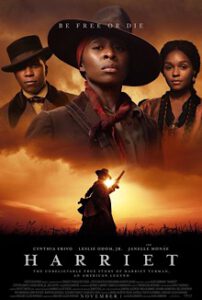 It’s not easy to make a biopic that pleases the critics. And, to some extent, Harriet, directed by Kasi Lemmons, falls into that category. Harriet weaves together facts about Harriet Tubman’s life into a compelling story, but some critics are not so enthusiastic about the film’s aesthetic qualities. In Harriet, there are no truly unusual composition of shots or camerawork the likes of 12 Years a Slave, and the physical horrors of slavery receive almost no screen time, leading some to wonder if audiences are sophisticated enough to fill in the gaps. The audience sees, for example, the scars of brutal beatings without any supporting dialogue. Thankfully, Lemmons resists the temptation to take an overly didactic or ‘preachy’ approach. Any aspects of slavery – and there are several – that the film does not cover can be dealt with as film preparation. It is unrealistic to believe that one film can show all there is to show about slavery. It’s not the focus of the film anyway. This is in, the words of its director, a “freedom film.”
It’s not easy to make a biopic that pleases the critics. And, to some extent, Harriet, directed by Kasi Lemmons, falls into that category. Harriet weaves together facts about Harriet Tubman’s life into a compelling story, but some critics are not so enthusiastic about the film’s aesthetic qualities. In Harriet, there are no truly unusual composition of shots or camerawork the likes of 12 Years a Slave, and the physical horrors of slavery receive almost no screen time, leading some to wonder if audiences are sophisticated enough to fill in the gaps. The audience sees, for example, the scars of brutal beatings without any supporting dialogue. Thankfully, Lemmons resists the temptation to take an overly didactic or ‘preachy’ approach. Any aspects of slavery – and there are several – that the film does not cover can be dealt with as film preparation. It is unrealistic to believe that one film can show all there is to show about slavery. It’s not the focus of the film anyway. This is in, the words of its director, a “freedom film.”
Both of these so-called limitations that I’ve just mentioned, however, make the film accessible to audiences of all ages and backgrounds. They further make Harriet, rated PG-13, an excellent film to explore with EFL students in upper-secondary schools, especially since teachers are deeply concerned about the impact of media violence on young people. Let’s face it, some scenes in 12 Years a Slave, rated R, may overwhelm or traumatize teenagers. Before outlining further reasons for using the film in the (German) EFL classroom and providing some original teaching materials for this action-packed film, let’s preview the trailer and get a taste of the experience:
https://www.youtube.com/watch?v=GqoEs4cG6Uw







